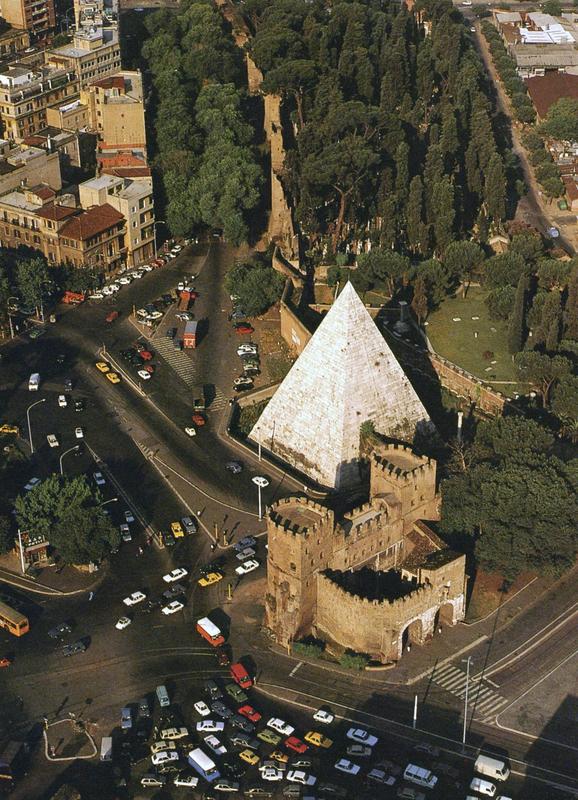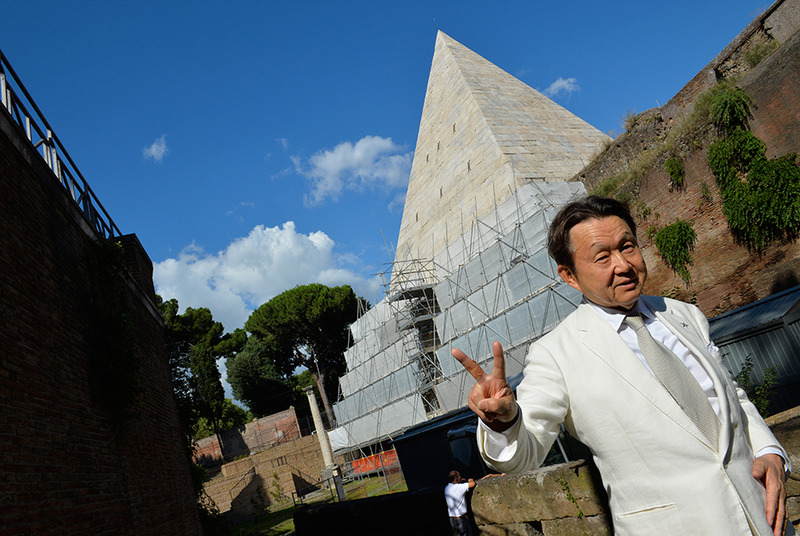Current Condition & Conservation Efforts

View of the Pyramid of Cestius with current traffic lanes and congestion. (Lefevre, Rome From the Air. Courtesy of Wellesley College Visual Resources Collection)
Until the nineteenth century, travelers on the Grand Tour saw the Pyramid of Cestius as the archetypical pyramid, rather than the less-accessible pyramids at Giza.1 Since then, travelers to the grave of John Keats (d. 1821) at the nearby Protestant Cemetery have waxed poetic about the Pyramid of Cestius.2 In the twentieth century, as World War II raged across Europe, bullets and bombs left marks that are still visible today, an unintentional record of the Pyramid’s later history.3
The modern city of Rome has grown up around the Pyramid, which is now surrounded by an intersection heavily trafficked by cars, a subway station (“Pyramide”), and a train station. In 2012, the Special Superintendency for the Archaeological Heritage of Rome recognized the critical condition of the monument, which had suffered from the buildup of car and train exhaust grime on the surface as well as the deformation of the marble cladding.4
Yugo Yazi, president of fashion importer Yagi Tsusho LTD in Japan, donated two million euros ($2.7 million USD) to restore the monument. At a ceremony at the monument on July 15, 2014, Yazi called his gift “an act of gratitude” for Italian fashion exports which helped grow his company. Italy’s culture ministry (like that of Greece, Spain, and other countries which have borne the weight of the global recession) suffers from chronic underfunding. Officials within the culture ministry hope that restoration of the Pyramid will be seen as a model for cooperation between the public and private sector.5
Restoration work, which began on November 26, 2012, was headed by architect Maria Filetici and archaeologist Rita Paris (who still oversees the Pyramid). The “conservative restoration” of the marble surface and the consolidation of the loosened cladding was completed (notably, on schedule) in the Fall of 2014.6 The constant pollution in Rome’s city center will be mitigated by teams of free-climbers spot-cleaning the monument on a monthly basis.7
______________________________________________________________________________
-
Donald M. Reid, Whose Pharaohs? Archaeology, Museums, and Egyptian National Identity from Napoleon to World War I (Berkeley: University of California Press, 2003), 58.
-
See, for example: Thomas Hardy’s 1903 poem, “Rome.”
-
Andreas Solaro, “Japanese Businessman Yuzo Yagi Thanks Italy with $2.7 Million Roman Pyramid,” Agence France Presse, July 15, 2014.
-
“The Restoration of the Pyramid of Gaius Cestius,” Soprintendenza Speciale per i Beni Archeologici di Roma, December 12, 2012. URL: http://archeoroma.beniculturali.it/en/events/current-events/restoration-pyramid-caius-cestius
-
Domenico Stinellis, “Rome's lonely Pyramid of Cestius gets a new lease of life,” Associated Press in Rome, February 3, 2016.
-
Andreas Solaro, “Japanese Businessman Yuzo Yagi Thanks Italy with $2.7 Million Roman Pyramid,” Agence France Presse, July 15, 2014.
-
Domenico Stinellis, “Rome's lonely Pyramid of Cestius gets a new lease of life,” Associated Press in Rome, February 3, 2016.
